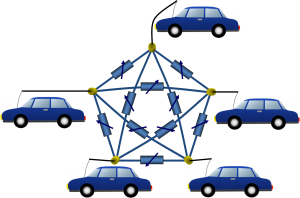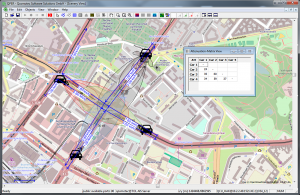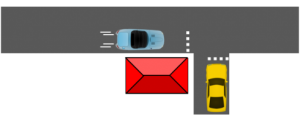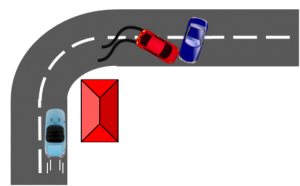 QPER-C2X is a special adaptation of the signal strength emulator QPER, designed for mobile and Vehicular Ad-hoc Networks (MANet and VANet). Every radio devices in such an infrastructure-less network acts as a sender, receiver, and forwarder (router). Therefore, the ports of the QPER-C2X hardware are fully connected with each other by dynamically controllable attenuators. The system is fully designed for frequencies up to 6 GHz, since wireless communication for Intelligent Transport Systems (ITS) is based on the WLAN standard IEE 802.11p from 5.850 MHz to 5.925 MHz. The connected ITS stations can be either on-board units, as they are built into cars, or road side units that are used by road infrastructure (traffic lights, road work area delimiters, velocity signs). For tests in the lab, radio modules of such ITS stations are each kept in a shielding box that prevents any unwanted radiation over the air.
QPER-C2X is a special adaptation of the signal strength emulator QPER, designed for mobile and Vehicular Ad-hoc Networks (MANet and VANet). Every radio devices in such an infrastructure-less network acts as a sender, receiver, and forwarder (router). Therefore, the ports of the QPER-C2X hardware are fully connected with each other by dynamically controllable attenuators. The system is fully designed for frequencies up to 6 GHz, since wireless communication for Intelligent Transport Systems (ITS) is based on the WLAN standard IEE 802.11p from 5.850 MHz to 5.925 MHz. The connected ITS stations can be either on-board units, as they are built into cars, or road side units that are used by road infrastructure (traffic lights, road work area delimiters, velocity signs). For tests in the lab, radio modules of such ITS stations are each kept in a shielding box that prevents any unwanted radiation over the air.
Virtual drive test software adapted to VANet simulation
 The attenuator settings are done by the QPER virtual drive test software – an easy and intuitive approach to create real-life like RF scenario tests. In a graphical user interface, the testers can drag and drop objects, that symbolize the usage of the radio device (cars, traffic lights, signs), onto a map. For creating a traffic scenario, users can specify trips and speeds for the cars. While executing such a traffic scenario, signal strength between all involved radio devices is calculated and the attenuator settings on all links are updated accordingly.
The attenuator settings are done by the QPER virtual drive test software – an easy and intuitive approach to create real-life like RF scenario tests. In a graphical user interface, the testers can drag and drop objects, that symbolize the usage of the radio device (cars, traffic lights, signs), onto a map. For creating a traffic scenario, users can specify trips and speeds for the cars. While executing such a traffic scenario, signal strength between all involved radio devices is calculated and the attenuator settings on all links are updated accordingly.
Signal strength calculation based on propagation effects
For calculating signal strengths, QPER takes the following parameters into account that are relevant for the radio channels:

- Distances between objects in the simulation
- Antenna radiation patterns that are either given by the radiation diagram of the used antenna or by the installation within the vehicle
- Shadowing between objects caused by buildings or other vehicles
- Fast Fading effects caused by multipath signal propagation
Optionally, the QPER hardware can be equipped with additional phase shifters (delay lines) on the radio links. This allows an even more precise emulation of multi-antenna systems, for example, if a car has front- and rear or side-mirror and roof antennas. In these setups, the delay lines emulate the phase differences of the various radio paths carrying identical channel information.
Traffic models cover all Day-One applications
Typical examples for traffic scenarios that can easily be created on a test bench are the Day-One applications for taking the Car-to-X communication on the road:
| Road Works | |
| Emergency Break | |
| Traffic Jam | |
| Slow Vehicle Ahead | |
| Vehicle in Approach | |
| Intersection Collision |  |
| Obstacle behind curve |  |
Technical Data of the QPER Hardware
| Number of input ports | 5, 7, 9, 13 or 17 |
| Number of bidirectional radio paths | 10, 21, 36, 78 or 196 |
| Frequency range | 0.8 – 6 GHz (covering all WLAN frequencies including IEE 802.11p standard) |
| Maximum input power | + 27 dBm (0,5 Watt) |
| Minimal emulated reception level | < -100 dBm (due to system insertion loss) |
| Dynamic attenuation range per path | 0 – 95 dB |
| Attenuation step size | 0.5 dB |
| Dynamic delay line range per path | 0 – 705 picoseconds |
| Delay line step size | 5.55 picoseconds |